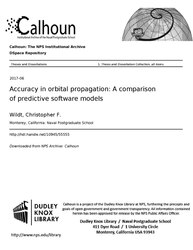File:Accuracy in orbital propagation- A comparison of predictive software models (IA accuracyinorbita1094555555).pdf

Original file (1,275 × 1,650 pixels, file size: 1.84 MB, MIME type: application/pdf, 130 pages)
Captions
Captions
Summary[edit]
| Accuracy in orbital propagation: A comparison of predictive software models
( |
||
|---|---|---|
| Author |
Wildt, Christopher F. |
|
| Title |
Accuracy in orbital propagation: A comparison of predictive software models |
|
| Publisher |
Monterey, California: Naval Postgraduate School |
|
| Description |
Current analytical satellite vulnerability planning in the U.S. Space Surveillance System is reliant on two orbital propagators, PPT3 and SGP4, both of which have a foundation in similar theory. Since their first operational use, both propagators have incorporated updated theory and mathematical techniques to model additional forces in the space environment, causing their calculation methods to diverge over time. The aggregate effects of these diverging mathematical techniques cause calculation differences for perturbations of an orbit over time, resulting in differences in future predicted positions from PPT3 and SGP4, as well as differences in their accuracy. The atmospheric model within each propagator is determined to be the most effective component of each propagator to test, as the theoretical atmospheric drag calculation methods of PPT3 and SGP4 differ greatly. PPT3 and SGP4 both perform well within the expected accuracy limits inherent with analytical models, with neither propagator demonstrating an accuracy rate decay that was significantly better or worse than the other. Compared to ground truth observations, both propagators demonstrate decreased accuracy for satellites under greater effects from atmospheric drag, i.e., satellites that are closer to the Earth. Satellite vulnerability planning with these propagators should therefore utilize the most current TLE data available to avoid accuracy errors. Subjects: orbital mechanics; orbital prediction software |
|
| Language | English | |
| Publication date | June 2017 | |
| Current location |
IA Collections: navalpostgraduateschoollibrary; fedlink |
|
| Accession number |
accuracyinorbita1094555555 |
|
| Source | ||
| Permission (Reusing this file) |
This publication is a work of the U.S. Government as defined in Title 17, United States Code, Section 101. Copyright protection is not available for this work in the United States. | |
Licensing[edit]
| Public domainPublic domainfalsefalse |
This work is in the public domain in the United States because it is a work prepared by an officer or employee of the United States Government as part of that person’s official duties under the terms of Title 17, Chapter 1, Section 105 of the US Code.
Note: This only applies to original works of the Federal Government and not to the work of any individual U.S. state, territory, commonwealth, county, municipality, or any other subdivision. This template also does not apply to postage stamp designs published by the United States Postal Service since 1978. (See § 313.6(C)(1) of Compendium of U.S. Copyright Office Practices). It also does not apply to certain US coins; see The US Mint Terms of Use.
|
 | |
| This file has been identified as being free of known restrictions under copyright law, including all related and neighboring rights. | ||
https://creativecommons.org/publicdomain/mark/1.0/PDMCreative Commons Public Domain Mark 1.0falsefalse
File history
Click on a date/time to view the file as it appeared at that time.
| Date/Time | Thumbnail | Dimensions | User | Comment | |
|---|---|---|---|---|---|
| current | 20:42, 13 July 2020 |  | 1,275 × 1,650, 130 pages (1.84 MB) | Fæ (talk | contribs) | FEDLINK - United States Federal Collection accuracyinorbita1094555555 (User talk:Fæ/IA books#Fork8) (batch 1993-2020 #5111) |
You cannot overwrite this file.
File usage on Commons
The following page uses this file:
Metadata
This file contains additional information such as Exif metadata which may have been added by the digital camera, scanner, or software program used to create or digitize it. If the file has been modified from its original state, some details such as the timestamp may not fully reflect those of the original file. The timestamp is only as accurate as the clock in the camera, and it may be completely wrong.
| Short title | Accuracy in orbital propagation: A comparison of predictive software models |
|---|---|
| Author | Wildt, Christopher F. |
| Software used | Wildt, Christopher F. |
| Conversion program | Microsoft® Word 2016 |
| Encrypted | no |
| Page size | 612 x 792 pts (letter) |
| Version of PDF format | 1.4 |

